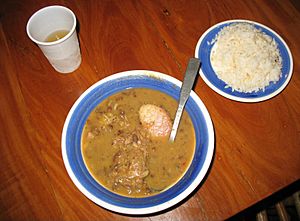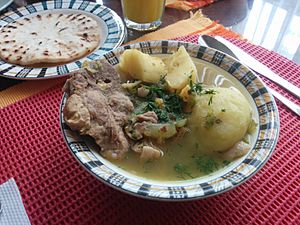Sancocho facts for kids

Sancocho de mondongo
|
|
| Type | Soup or stew |
|---|---|
| Place of origin | Latin America |
| Region or state | Americas |
| Associated national cuisine | Colombia, Cuba, Dominican Republic, Ecuador, Honduras, Panama, Puerto Rico, and Venezuela |
| Main ingredients | Meat, vegetables, broth, yuca, platano |
Sancocho is a tasty and hearty soup or stew popular in many Latin American countries. The name "Sancocho" comes from the Spanish word sancochar, which means "to partially cook". This delicious dish is often considered a national dish in places like Puerto Rico, Honduras, Ecuador, Colombia, Cuba, Panama, Dominican Republic, Trinidad and Tobago, and Venezuela.
Sancocho usually has big pieces of meat, root vegetables (called tubers), and other vegetables. All these ingredients are cooked together in a flavorful broth. It's a comforting meal that many families enjoy, especially on weekends or for special celebrations.
Contents
Sancocho Around the World
Sancocho is made differently in various countries. Each place adds its own special touch to this popular soup.
Puerto Rican Sancocho
In Puerto Rico, sancocho is a simple, country-style dish. It can be made with chicken, smoked ham, or beef. Some versions even use pork feet with chickpeas. There's also a "Caldo Santo" version with fish and shellfish cooked in coconut milk.
Every family has its own way of making sancocho. However, a true Puerto Rican sancocho always includes corn on the cob. It also has different root vegetables, squash, green bananas, and meat. This filling stew is often served with a small bowl of rice. People might also add pique criollo (a spicy sauce), tostones (fried plantain slices), and bread.
Venezuelan Sancocho
In Venezuela, sancochos are very popular, especially on weekends. You can find them with beef, chicken, or even goat meat. Some types mix two kinds of meat, which is called "cruzado."
Common vegetables in Venezuelan sancocho include yam, potato, cassava (yuca), and corn. Other ingredients are celery, taro, pumpkin, and green banana. Fresh herbs like cilantro and hot peppers add flavor. These soups are often a main meal and are not usually served with other foods. They are a common dish at celebrations, like Christmas or New Year's Day lunch. People sometimes just call it "soup."
Sancocho in Trinidad and Tobago
In Trinidad and Tobago, this dish is known as sancoche or "Saturday soup." This is because, like in Venezuela, it's mostly eaten on the weekend. The fish version is called "fish broff." These soups are often spiced heavily with green seasoning, pimiento, and hot peppers. It's usually served with cassava or arepas (corn cakes). Some people like to add lemon juice, especially to the fish version.
Colombian Sancocho
Sancocho is a traditional food in Colombia. It's made with many kinds of meat, such as chicken, pork ribs, or fish. It always includes large pieces of plantain, potato, and cassava. Other vegetables like tomato, scallion, and corn on the cob are also added.
Some people top their sancocho with fresh cilantro, onion, and lime juice. This is like a simple "pico de gallo" (a fresh salsa). It's also often served with sliced avocado and a plate of white rice. People usually dip the rice into the soup with each spoonful.
Ecuadorian Sancocho
In the "Sierra" region of Ecuador, sancocho is also known as fritada. It's a comforting dish made with pork. In the coastal areas, it's similar to the Colombian sancocho. It includes typical ingredients like yuca, plantain, and corn. It can be made with fish, chicken, oxtail, or beef.
Dominican Sancocho
In the Dominican Republic, "sancocho" is considered one of the national dishes. There's a special kind called sancocho cruzado or sancocho de siete carnes. This means "seven meat sancocho" and includes chicken, beef, pork, and other meats. Longaniza, a type of pork sausage, is also used.
Sancocho de gallina (hen sancocho) is also common. It's often made for special occasions or on weekends. While bean sancocho is also popular, other types are quite rare.
Panamanian Sancocho
Also known as sancocho de gallina, this is the national dish of Panama. The main ingredients are chicken, ñame (a root vegetable that thickens the soup), and culantro (a herb that gives it a special flavor and greenish color). Often, yuca, corn on the cob, and otoe are added.
Other ingredients can include chopped onions, garlic, and oregano. It's often served with white rice on the side. People can mix the rice into the soup or eat it with each spoonful. Hot sauce is often added for extra flavor.
There are regional types, like Sancocho chorrerano from La Chorrera. This one is only made with free-range chicken, onions, garlic, chili peppers, oregano, and ñame. Sancocho chiricano from Chiriquí Province is the heartiest type. It includes squash and has a yellowish color. Sancocho is sometimes used as a way to describe Panama's diverse culture. This is because all the different ingredients come together to make one delicious dish.
Sancocho in El Salvador
In El Salvador, sancocho is a stew made with parts of cattle, like the tripe (stomach).
Sancocho in the Philippines
Reflecting its Spanish influence, sancocho is also eaten in the Philippines. There, it's known as cocido. This hearty stew can be made with fish, beef shanks, chicken, pork, bacon, and different sausages like chorizo and morcilla (Spanish blood sausage). It also includes vegetables like yucca, potatoes, cilantro, corn, cabbage, bok choy, carrots, and string beans. It is sometimes confused with puchero Filipino, which uses different ingredients.
See also
 In Spanish: Sancocho para niños
In Spanish: Sancocho para niños



